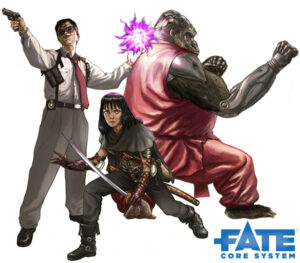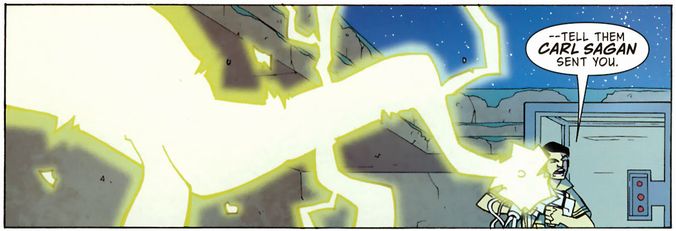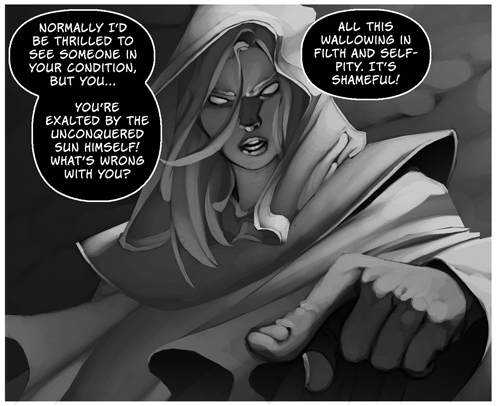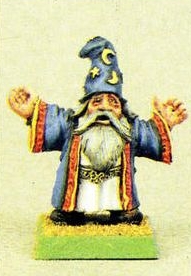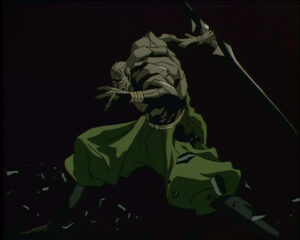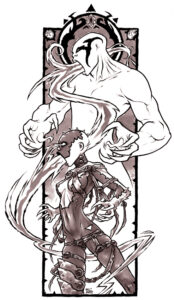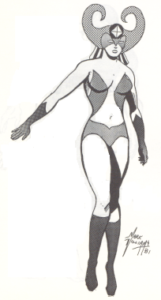
Supers RPG Games. What can I say about them briefly? They are a guilty pleasure at best and at worst a one shot farce where people make characters that are walking beer mugs named Mr. Frothy. Over the long years I’ve run the Hero System, TMNT and Champions and while they didn’t totally suck (TMNT, embarrassingly was probably the best in play), each had their quirks. The Hero system has a lot of “Math.” Champions took forever to make a character build (our first experience with a points buy as kids) and the fights took a long, long time. Even for us children, they were fun dalliances from the serious stuff like D&D and Call of Cthulhu (and Gamma World)–not the stuff of a long campaign. Once the cynicism of the late 80’s set in along with Warhammer Fantasy Roleplay, there was no going back to the genre. A Supers games was all fighting: there wasn’t much narrative other than punch the shit out of some Viper agents and take down Armadillo with a RKA before he has a chance to act. While fun, the other factor was that your character didn’t build up with experience– they came out of the womb about as powerful as they were going to get. I think very very few sessions of Supers games were played for these reasons, but we did spend much more time making characters. Somewhere I have a pile of moulding character sheets for Champions with all the Xmen, Rom the Spaceknight and probably ridiculous characters like Devil Dinosaur and Kamandi (the last boy on earth you know). This is where time was spent on these games, not the play itself.
However, in the last 20 years, two games hit the shelves that can only be described as Supers games: Feng Shui and Exalted. in 2007, the capstone on the superhero genre hit the shelves in the form of Exalted 2nd Edition. Think Exalted isn’t a supers game? Look at it. Seriously. While Exalted has it’s problems, some GLARING problems, the setting and the ability for a system to FEEL like you are playing an uber powered individual with nuanced power sets really put everything else I had played before back on the shelves (including Feng Shui). Everything in the “Supers” genre, from ICONS to Kerberos Club to the new Marvel Heroic Roleplaying is trying to capture that magic that Exalted brought to the table while trying NOT to fall into the traps Exalted did from a system perspective.
That said, now we are older and have responsibilities other than finding a dark corner to beat off in or making sure we actually eat something other than funyons during a given Summer day spent in a dank basement. There’s no time to make characters, there’s barely time to PLAY a game, much less know the rules to the extent Champions/Hero system requires. And let’s not even get into the whole Exalted 2nd edition complications. So we turn to FATE-like games with a focus on narrative and player-fiat rather than system heavy simulation. While it uses what’s called the Cortex system, MHR is, in essence, FATE with the D&D dice (and lots of them). This is not a bad thing.
While I had read the MHR rules once through and skimmed them again right before play, I must admit, I was largely unprepared for being the GM (Watcher). I understood what the Doom pool was, how dice pools were made for actions, but had a good deal of fuzziness around the nuances rules. Of course, the first scenario is about the best I’ve read in a Supers game– all full on combat with other super villains– an asston of them pouring down. In fact ,there are so many that mobs of them show up as Mooks and you can spend dice from the Doom Pool to ‘power’ up some out of this huge list of D-grade villains like Scarecrow, Mentallo and Tiger Shark in the back of the book. I planned on the entire session being combat, and oh yeah, it was. While some players shudder at session-long combats, don’t let that throw you off– it went surprisingly fast for what it was–a MAJOR throw down. Running four major super heroes (Thor, Iron Fist, Iron Man and Wolverine) vs seven+ supervillains including one A-lister in the form of Carnage his bad self actually worked. Trying to run seven villains and all their powers at once in the first session of a new game seems totally insane– and at first it was, but characters don’t have a ton of powers that you can’t remember at all (like Exalted), so you’re not overwhelmed. It’s what you do with those powers both in the narrative and with your dice that make the difference (again, remember this is FATE-like). I fucked up a few times, sure, like using Living Laser’s LIMIT on his power set as a power (stupid me) and not quite doing Count Nefaria’s powers right…but compared to running 6-8 mere Dragon Blooded in Exalted, it was a total cakewalk as a GM.
Given that the core system is essentially FATE, I must comment on the change in dice in MHR from the Fudge ones. Unlike FATE, you have a dice pool that you build from your character sheet, from resources and assets (like a tire iron you picked up, or a tank you are about to throw in the case of the Thing) or enemy consequences. You roll these dice and select two for your ‘to hit’ roll and select one die for effect. The effect die number showing has no meaning, just the size of the die. Your opposition rolls against that ‘to hit’ number to dodge or block, building a pool in the same manner you did to hit and also selects and effect die and a ‘to hit’ roll. Essentially whoever gets higher gets to fuck the other character up– the only difference is that the attacker gets to do so for free and the defender has to spend a Plot Point to apply his effect. This means the dreaded WHIFF factor is nearly gone– if you miss, chances are you are going to take some damage in return. Players thought the counterattack mechanism was overpowered, but really, what it comes down to is a roll off and whoever wins can hit– attacker for free but with no information (dice haven’t been rolled) the defender ‘at cost’ but with all the information (dice are already rolled).
Damage takes the form of a die type and is either a consequence (like being wrapped in cabling) or some form of Stress (like FATE). So, if you have D10 damage, that’s not only a track to see how fucked you are, but bonus die your opposition gets to roll against you. Once it’s over D12, you are out of the scene and take some real damage. Damage can happen FAST. In the first exchange, if Thor hadn’t had a Plot Point to invoke his invulnerable power, he would have been one-shotted by Living Laser. The heroes were one shotting villains all over the place– and some of these guys were plenty ‘ard. Like FATE, when you are in combat, things HAPPEN.
The dice pool mechanic was pretty quickly picked up by the players but it must have been crazy for them in the first hour or so. They were able to build their pools quickly throughout the game– though I think it wasn’t exactly correct because though you can use a die from each ‘section’ of your character sheet, that doesn’t mean you are legally allowed to. For example if you were trying to punch someone, you can’t use a “criminal master” D10 for your free trait die– it just doesn’t make sense. My only complaint is that I hate D4’s: hate rolling them, hate reading the numbers off and hate stepping on the fucking things late at night. Otherwise the dicepool works really well. It’s not as fast as FATE, but it doesn’t take forever and seems to squeeze out narration.
I’d be remiss if I didn’t talk about the powers in the game. Powers are called ‘Power Sets’ that include all special effects and a limit. Most characters have but one power set, but some have 2-3. The special effects are things like: “Remove your Stress die to the doom pool and step up your next attack effect die by one rank” and really represent the player’s powers in the game. The Limit is some condition that shuts down the power set (like Iron Man having his armor power shut down by an EMP). These limits were tough to integrate during the first play– I just didn’t know if I was supposed to show them to the players or not. You do not play with a GM screen and nothing is hidden from the players so I would assume they could just look on the enemy sheets. Again, the number of powers and effects are manageable and it’s possible to run a shitload of NPC’s with no problem: something that cannot be said for ANY other Supers game I’ve played.
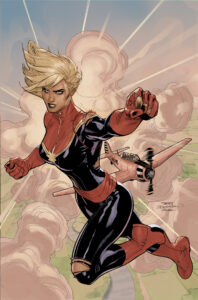
In summary, the first session was chaotic but showed a lot of potential for the system. I need to run the game again (and explain the rules better to the group) to see if players get bored of the system and all the dice or if it stays fresh. Like most other Supers games, there isn’t really any reason to use or get experience points– but they are there and there is some leveling up, but for the stock Marvel characters– who cares? In short, MHR really this blows away Champions and the Hero system because I could sit down and run the game with little to no prep, much like FATE. With practice, I could probably make up villains on the fly during play. The issue, creatively, is I’m not sold on and RPG based around MARVEL, you can’t really make characters easily and while the system isn’t tied to the setting all that much, who on earth has the time to make an alternate setting? That said I will run this fucker again, despite the fact that the main characters have underwear with them on it that your kids would wear and lunchboxes and toys from the 70’s and are pretty much played out story wise (I never noticed how fucking LAME wolverine’s ‘Japanese’ backstory really was– oh the 80’s…) but it would be nice to get off the generic Marvel heroes in the book (FF, Xmen and Avengers,with the only B-listers being Power Man and Iron Fist) and onto stuff like the Lesbian Space Adventures of Phyla-Vell or you know… something closer to EXALTED.
